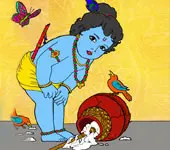Comments
Recommended for you
Putrakameshti Yaga of Dasharatha

The Putrakameshti Yaga of Dasharatha is a significant event in Ramayana, It was performed after the Ashwamedha Yaga. Dasharatha specifically prayed fo....
Click here to know more..Is Family's Permission Necessary For Becoming Sanyasi ?

Is family's permission necessary for becoming a sanyasi? Who is a sanyasi? Bhagawan says in Gita - योगसंन्यस्तकर्माण....
Click here to know more..Krishna Lahari Stotram

praseedeti kroshannimishamiva neshyaami divasaan. kadaa drakshye poornam purushamamalam pankajadri'sham aho vishno yogin rasikamuraleemohana vibho. da....
Click here to know more..
English Topics
Vedas
Click on any topic to open
- 86 Wealth in the Vedic Society
- 85 Culture vis-a-vis Agriculture
- 84 Whenever I have Read any Part of the Vedas
- 83 Vedas - Holy Books Of Hinduism
- 82 How The Vedas Manifested Into Material Objects
- 81 What does Rigveda contain?
- 80 Why Vedas are called Shruti?
- 79 What Vedas say about periods
- 78 How Vedas Came Into Existence
- 77 Vedas are eternal, not written by anyone
Please wait while the audio list loads..
30
Ganapathy
Shiva
Hanuman
Devi
Vishnu Sahasranama
Mahabharatam
Practical Wisdom
Yoga Vasishta
Vedas
Rituals
Rare Topics
Devi Mahatmyam
Glory of Venkatesha
Shani Mahatmya
Story of Sri Yantra
Rudram Explained
Atharva Sheersha
Sri Suktam
Kathopanishad
Ramayana
Mystique
Mantra Shastra
Bharat Matha
Bhagavatam
Astrology
Temples
Spiritual books
Purana Stories
Festivals
Sages and Saints
